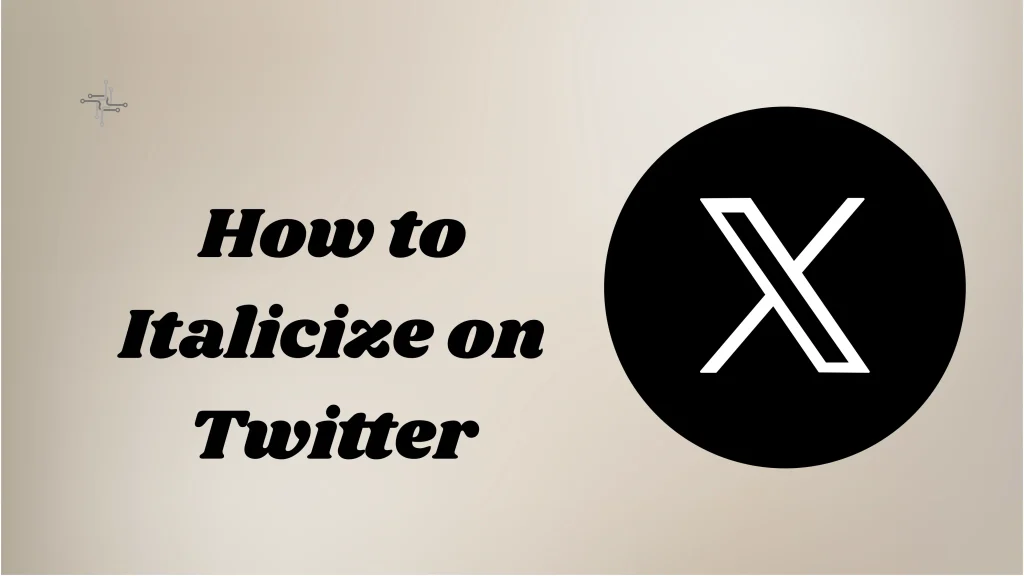Text formatting on social media helps make your posts stand out. It allows you to emphasize certain words or phrases, making your message clearer. Whether it’s for creating impact or highlighting key information, formatting plays a big role in how your audience engages with your content. It helps break up long posts and adds style, which can grab attention quickly.
Italics, in particular, are useful for adding emphasis without being too bold or loud. On Twitter, where space is limited, italics can help convey tone or importance subtly. By italicizing specific words or phrases, you can guide your audience’s attention to what’s most important.
Table of Contents
Why Italicizing on Twitter Matters
Italicizing on Twitter matters because it allows you to emphasize specific words or phrases in your posts. In a limited character space, it’s important to make key points stand out. Italics provide a subtle way to highlight important information without being too loud or disruptive. This helps guide your audience’s attention to what matters most in your tweet.
Italics also give your tweets a more polished and professional appearance. Instead of using all caps or other more aggressive methods of emphasis, italics offer a softer yet effective approach. This helps maintain readability while still drawing attention to the key message you want to convey.
Moreover, using italics can improve the tone of your message. Whether you’re sharing an opinion or pointing out something important, italics can help show intent or differentiate a particular word. This makes your tweets feel more thoughtful and deliberate.
Methods to Italicize Text on Twitter
Using HTML Tags
Twitter doesn’t directly support HTML formatting in tweets, but you can use HTML tags like <i> to italicize text. To do this, you need to write your text with the HTML tag in an external text editor or tool that supports HTML. Then, copy and paste the text into Twitter. However, note that this method may not work consistently across all devices and browsers.
Using Unicode Italics
A more reliable method is to use Unicode italics. There are various online tools and websites that allow you to convert regular text into italicized Unicode characters. Once you’ve generated the italicized text, simply copy and paste it into your tweet. This method works well because Unicode italics are supported across most platforms and devices, ensuring your text appears correctly.
Limitations of Italicizing on Twitter
Lack of Native Support for Italics
Twitter does not offer built-in support for italics, unlike platforms such as Facebook or Instagram. There’s no option in the text editor to format your tweets with italics. This limitation means you need to rely on external methods like HTML tags or Unicode characters, which can be cumbersome and not always reliable.
Inconsistent Formatting Across Devices
Using workarounds like HTML tags or Unicode characters may not work consistently across all devices and browsers. While some users may see your italicized text as intended, others may not see any formatting at all, which can lead to confusion or a poor user experience. This inconsistency makes it difficult to ensure your message is received clearly by everyone.
Character Limit Constraints
Twitter’s 280-character limit makes it tough to effectively use italics for longer or more complex messages. While italics can be used to emphasize short phrases, you may run out of space when trying to italicize a more detailed message. Balancing formatting with Twitter’s character constraints can be tricky, and it often means you have to keep your messages concise.
Best Practices for Using Italics on Twitter
Use Sparingly
Italics should be used to highlight key points, not to emphasize everything in a tweet. Overusing italics can make your message feel cluttered and less impactful. Reserve italics for important words or phrases that truly need emphasis, such as important dates, names, or concepts.
Focus on Clarity
Ensure that the text you italicize adds clarity to your message. Italics should make your message easier to understand or help convey tone. Use them to highlight crucial information without confusing or overwhelming your audience.
Pair with Other Formatting Techniques
Since Twitter lacks native italic support, combining italics with other emphasis methods, like bold text or emojis, can make your tweet stand out more. Use italics in combination with punctuation or clear structure to make your message visually engaging and readable.
Test Before Posting
Before you publish a tweet with italicized text using workarounds, test it to ensure the formatting appears as intended. Double-check on different devices and browsers to make sure the italics are visible to your audience, helping avoid formatting errors.
Stay Consistent with Tone
Make sure that the use of italics aligns with the tone of your tweet. Italics work best for adding subtle emphasis or indicating a shift in meaning. Avoid using italics in a way that could create confusion or detract from the overall tone of your message.
Alternative Ways to Emphasize Text on Twitter
- Use Bold Text: While Twitter doesn’t natively support bold text, you can use online tools to convert text into bold Unicode characters. Once converted, you can copy and paste the bold text into your tweet. Bold text can be used to draw attention to key points or important terms in a tweet.
- Utilize Capitalization: Capitalizing certain words can help make them stand out in a tweet. This is a simple way to add emphasis, but it’s important not to overdo it, as excessive capitalization can come across as shouting. Use it for emphasis on single words or phrases that need to grab attention.
- Add Emojis: Emojis can be a fun and creative way to emphasize your message on Twitter. Use them to highlight certain points, add personality to your tweet, or simply draw attention. Emojis are highly visible and often stand out more than plain text.
- Punctuation Marks: Excessive or strategic use of punctuation marks, such as exclamation points or question marks, can emphasize certain parts of your tweet. For example, “That was AMAZING!” or “Are you ready for this???” can make your message more dynamic and draw focus to the most important parts.
- Break Text into Shorter, Punchy Sentences: Short, punchy sentences tend to stand out more in Twitter feeds. Breaking up your tweet into shorter lines makes the message easier to read and adds emphasis to each point. This keeps your tweet engaging and ensures the important details aren’t lost in a large block of text.
Conclusion
Twitter doesn’t have a built-in feature to italicize text. However, you can use workarounds like HTML tags or Unicode characters to get the job done. For HTML tags, you can use the <i> tag in an external tool and then copy-paste it into Twitter. For Unicode, use an online tool to convert text into italicized characters, then copy and paste that text.
These methods are not perfect and may not display consistently across all devices. But using these tools, you can still add emphasis to important words or phrases in your tweets. It’s a simple way to make your content stand out.


